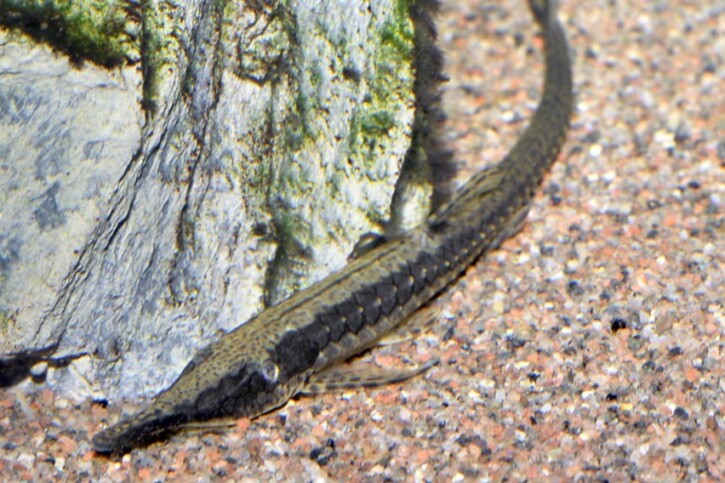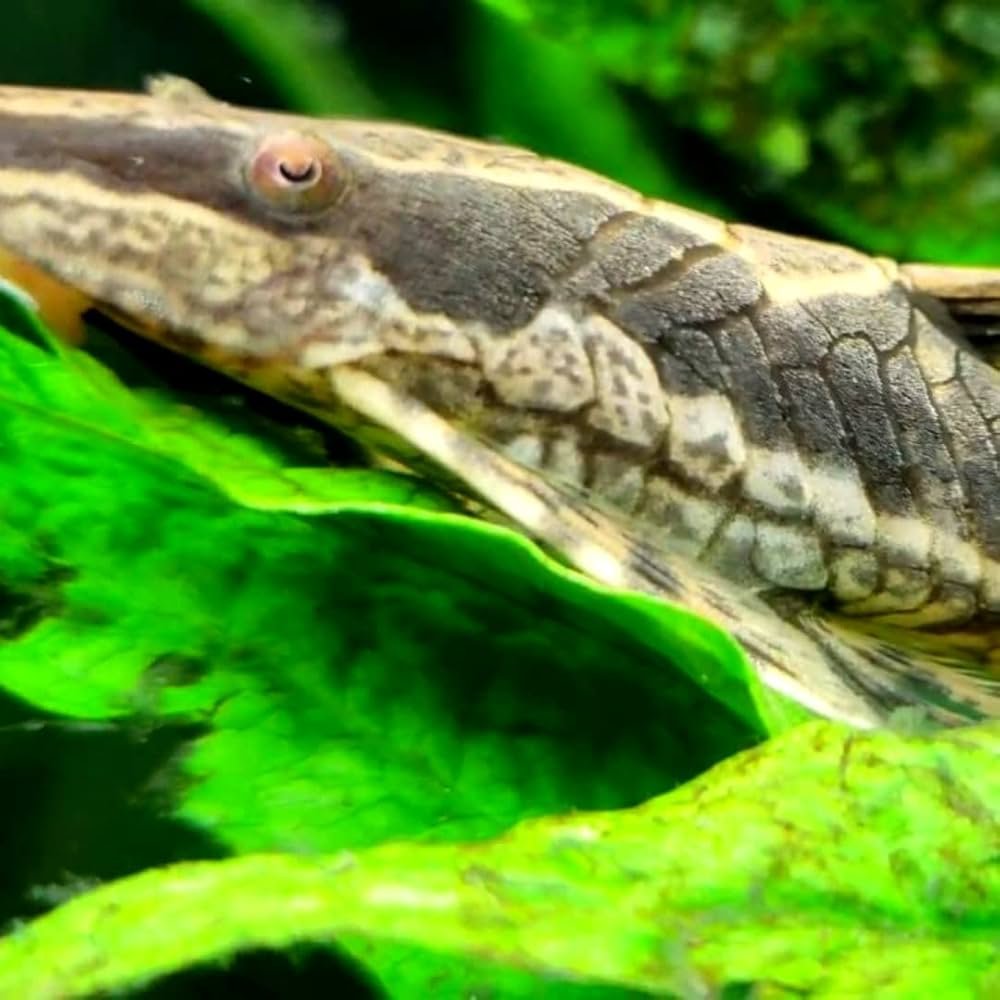Farlowella Catfish can face health problems like Ich and fin rot. Poor water quality can also lead to stress and illness.
Farlowella Catfish, also known as Twig Catfish, are delicate creatures. They thrive in well-maintained aquariums with stable water conditions. These catfish are sensitive to changes in their environment, making them prone to health issues. Common problems include Ich, a parasitic infection, and fin rot, a bacterial disease.
Maintaining clean water and a balanced diet is crucial for their well-being. Regular water testing and tank maintenance can prevent most health issues. Observing their behavior and appearance helps in early detection of diseases. Providing a stress-free environment ensures they stay healthy and active.

Credit: riverparkaquatics.co.uk
Common Health Issues
The Farlowella Catfish, known for its twig-like appearance, can face several health problems. Being aware of these common issues helps in maintaining their health. Below, we discuss the most frequent health challenges.
Fungal Infections
Fungal infections are common in Farlowella Catfish. These infections often appear as white or gray patches on the fish’s skin. Fungal infections can be due to poor water quality or injuries.
To prevent fungal infections, maintain clean water. Use a high-quality water filter. Quarantine new fish before adding them to the tank. Treat infected fish with antifungal medications available at pet stores.
| Causes | Prevention | Treatment |
|---|---|---|
| Poor water quality | Regular water changes | Antifungal medications |
| Injuries | Quarantine new fish | Improve water quality |
Parasite Infestations
Parasites can be a serious problem for Farlowella Catfish. Common parasites include ich, flukes, and worms. These can cause severe stress and health issues.
Signs of parasite infestations include scratching against surfaces and visible spots or worms. Ensure a clean environment to prevent parasites. Regularly inspect your fish for any signs of infestation.
Treating parasites often involves medicated baths or food. Consult a vet for the best treatment options. Use medications specifically designed for aquarium fish.
- Ich: White spots on the skin
- Flukes: Gills and skin irritation
- Worms: Visible worms in the body
Keep a close eye on your Farlowella Catfish. Early detection is key to effective treatment. Always maintain a clean and healthy tank environment.

Credit: www.fishi-pedia.com
Symptoms To Watch For
Farlowella Catfish, also known as Twig Catfish, are unique and sensitive creatures. Keeping them healthy requires knowing the symptoms of potential health problems. Early detection ensures your Farlowella Catfish stay in optimal condition.
Physical Signs
Physical changes are often the first indicators of health issues in Farlowella Catfish. Watch for the following signs:
- White Spots: These can indicate Ich, a common parasitic infection.
- Red Streaks: These may suggest bacterial infections or poor water quality.
- Frayed Fins: This could be a result of fin rot or bullying from other fish.
- Sunken Eyes: This often points to malnutrition or a more serious illness.
- Discoloration: Pale or dark spots can signify stress or disease.
Regularly inspect your fish for any physical abnormalities.
Behavioral Changes
Behavioral shifts can also signal health problems. Keep an eye out for:
- Lethargy: Healthy Farlowella Catfish are active and curious. Lethargy can indicate illness.
- Erratic Swimming: Sudden, jerky movements may suggest parasites or poor water conditions.
- Loss of Appetite: If your catfish stops eating, it could be sick.
- Hiding: Excessive hiding might mean the fish is stressed or unwell.
- Gasping at Surface: This often indicates low oxygen levels in the tank.
Monitoring these behaviors helps catch issues early.
Understanding these symptoms ensures your Farlowella Catfish remain healthy and vibrant.
Preventive Measures
Keeping your Farlowella Catfish healthy involves several important steps. By focusing on preventive measures, you can ensure their well-being and avoid common health problems. Below are key areas to focus on.
Water Quality
Water quality is crucial for Farlowella Catfish. Ensure the water is clean and well-filtered. Use a high-quality water filter to remove impurities. Regularly test the water’s pH level and maintain it between 6.5 and 7.5. Keep the water temperature between 72°F and 79°F. Change 20% of the tank water weekly to maintain optimal conditions.
Here’s a quick checklist for water quality:
- Use a high-quality filter
- Test pH levels regularly
- Maintain temperature between 72°F and 79°F
- Change 20% of tank water weekly
Diet And Nutrition
A balanced diet is essential for Farlowella Catfish. Feed them a variety of foods to ensure they get all the nutrients they need. Provide algae wafers as a staple in their diet. Supplement with fresh vegetables like zucchini and cucumber. Offer high-quality fish flakes and occasional protein-rich treats like brine shrimp.
Here is a sample diet plan for your Farlowella Catfish:
| Day | Food |
|---|---|
| Monday | Algae Wafers |
| Tuesday | Fresh Zucchini |
| Wednesday | High-Quality Fish Flakes |
| Thursday | Algae Wafers |
| Friday | Fresh Cucumber |
| Saturday | Brine Shrimp |
| Sunday | Algae Wafers |
Ensure you feed them in small amounts, twice a day. Overfeeding can lead to health issues and poor water quality.
Quarantine Practices
Quarantining your Farlowella Catfish ensures they stay healthy. This practice helps prevent the spread of diseases. It also gives you time to observe and treat any health issues.
Isolation Tanks
Isolation tanks are essential for quarantine. These tanks should be separate from your main aquarium. They need proper filtration and aeration. A 10-20 gallon tank is usually enough.
Keep the water parameters similar to the main tank. This helps reduce stress on the fish. Include hiding spots like plants or decorations. This makes the fish feel safe.
Observation Period
The observation period is crucial for spotting health issues. Typically, this period lasts 2-4 weeks. During this time, watch for signs of disease or stress.
Check for symptoms like:
- White spots or patches
- Fin rot
- Unusual swimming behavior
- Loss of appetite
Maintain a daily log of your observations. This helps track any changes in the fish’s condition. If you notice any issues, treat them immediately.
Use the observation period to acclimate new fish. Gradually introduce them to the main tank conditions. This helps them adjust better.
Treatment Options
Farlowella Catfish, known for their unique appearance, can face health problems. Treating these issues promptly is crucial to ensure their well-being.
Medications
Medications can help treat common Farlowella Catfish health problems. Here are some commonly used treatments:
| Health Problem | Medication | Dosage |
|---|---|---|
| Ich | Copper-based treatments | Follow package instructions |
| Fungal Infections | Antifungal medications | 1 tsp per gallon |
| Bacterial Infections | Antibiotics | Depends on the type |
Natural Remedies
Natural remedies are another way to treat Farlowella Catfish health problems. They are safer for the environment and the fish.
- Salt Baths: Use aquarium salt. Add 1 tsp per gallon. This can help with minor infections.
- Garlic: Crush garlic and mix with their food. Garlic boosts the immune system.
- Tea Tree Oil: Use a few drops in the water. This can help with fungal infections.
Both medications and natural remedies can be effective. Always monitor your fish’s progress closely.
Environmental Factors
Maintaining a healthy environment is crucial for Farlowella Catfish. These fish are sensitive to changes in their habitat. Poor water quality can lead to stress and disease. Below, we explore key environmental factors that affect their health.
Tank Setup
A proper tank setup is essential for Farlowella Catfish. They need a spacious tank with plenty of hiding spots. Include driftwood, rocks, and live plants. These elements mimic their natural habitat.
Consider a tank size of at least 20 gallons. This provides ample room for swimming and hiding. Ensure the tank has a soft, sandy substrate. Hard substrates can damage their delicate whiskers.
| Tank Size | Substrate | Decorations |
|---|---|---|
| 20+ gallons | Soft, sandy | Driftwood, rocks, plants |
Temperature Control
Farlowella Catfish thrive in specific temperature ranges. The water temperature should be between 72-79°F (22-26°C). Use a reliable aquarium heater to maintain this range.
Fluctuating temperatures can cause stress. Stress makes fish more prone to diseases. A thermometer helps monitor water temperature accurately.
Consider using a heater with a built-in thermostat. This ensures consistent temperature control. Regularly check the heater’s functionality to avoid sudden changes.
- Keep temperature between 72-79°F (22-26°C)
- Use a reliable heater
- Monitor temperature with a thermometer
Stress Reduction
Stress can cause significant health problems for Farlowella catfish. Reducing stress helps them live longer. This section discusses how to reduce their stress.
Minimizing Disturbance
Farlowella catfish are sensitive to disturbances. Keep their environment stable. Do not change tank decorations often. Sudden changes can stress them.
Avoid loud noises near the tank. Farlowella catfish can get scared easily. Keep the tank in a quiet room. This helps them feel safe.
Proper Tank Mates
Choose tank mates carefully. Farlowella catfish need peaceful companions. Aggressive fish can cause stress. Good tank mates include:
- Neon Tetras
- Guppies
- Small Corydoras
Avoid larger, aggressive fish. They can harm Farlowella catfish. Keep their tank mates small and friendly. This ensures a calm environment.
Stress reduction is vital for Farlowella catfish health. A peaceful, stable environment keeps them happy and healthy.

Credit: www.amazon.com
Regular Monitoring
Regular monitoring is crucial for keeping Farlowella Catfish healthy. Consistent checks help detect problems early. This reduces the risk of severe health issues. Let’s look into important aspects of regular monitoring.
Health Checks
Performing regular health checks is essential. Look for signs like:
- Loss of appetite
- Unusual spots or lesions
- Erratic swimming
Water Testing
Water quality affects your catfish’s health. Regular water testing helps maintain a healthy environment. You need to test for:
- pH levels
- Ammonia
- Nitrites
- Nitrates
| Parameter | Ideal Range |
|---|---|
| pH | 6.5 – 7.5 |
| Ammonia | 0 ppm |
| Nitrites | 0 ppm |
| Nitrates | Below 20 ppm |
Keeping these parameters in check ensures a healthy habitat for your Farlowella Catfish. Regular water changes also help maintain these levels. Aim for at least a 25% water change every two weeks.
Frequently Asked Questions
What Is The Lifespan Of A Farlowella?
The lifespan of a Farlowella is typically 5 to 10 years. Proper care and a suitable environment can extend their life.
What Do Farlowella Catfish Eat?
Farlowella catfish eat algae, biofilm, and plant matter. They also enjoy blanched vegetables and sinking algae wafers.
What Is The Temperament Of The Farlowella?
Farlowella fish are peaceful and calm. They thrive in community tanks with non-aggressive species. They prefer slow-moving environments.
What Is The Minimum Tank Size For Farlowella Catfish?
The minimum tank size for Farlowella catfish is 20 gallons. They need space to swim and hide. Ensure good water quality.
Conclusion
Maintaining a healthy environment is crucial for Farlowella catfish. Regular water changes and proper diet prevent common health issues. Always monitor their behavior and appearance. Early detection of problems ensures effective treatment. Prioritize their well-being for a thriving aquarium. Your Farlowella catfish will thank you with long, healthy lives.
